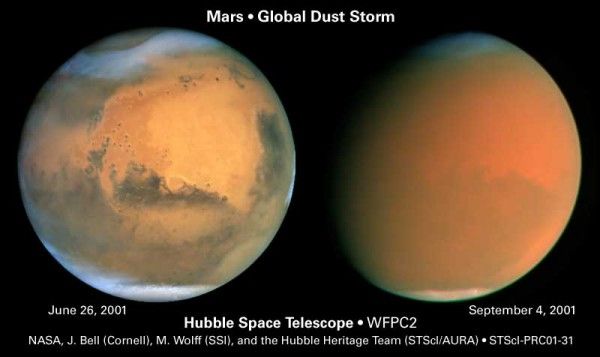Mars Weather Forecast Calls for Massive Dust Storms — Here’s Why
Planetary-wide dust storms on Mars, lasting for months, may be linked to the motion of the Red Planet around the solar system.
/https://tf-cmsv2-smithsonianmag-media.s3.amazonaws.com/filer/68/5e/685e9a47-3087-4bb7-b731-716ba4d861cd/artists-concept-mars-martian-dust-storm-electricity-br2.jpg)
In a few months, a planetary-wide dust storm may cover Mars, blocking light from the sun and hiding its features. While local dust storms are fairly common, global dust storms are rarer, occurring at irregular times that have previously defied prediction.
But by studying the movement of the planets in the solar system, scientists may have a new tool to forecast future storms.
The global dust storms may be linked to the motion of Mars around the gravitational center of the solar system. Although the sun is the most massive resident, the additional weight of its satellites means that its core isn't the midpoint of the system. Even the sun must circle the gravitational center of the solar system, causing a slight wobble in the star's orbit. This wobble has been tentatively linked to its sunspots, but for the first time, researchers are also linking it to weather on a planet.
James Shirley, an atmospheric scientist at NASA's Jet Propulsion Laboratory in California, compares the movement of Jupiter and the sun, the largest objects in the solar system, to a pair of ice skaters holding hands as they whirl round one another—and around their combined center of gravity. In the solar system, however, all the planets contribute somewhat to the frolic.
"It's kind of a big dance, it's not just the two little ice dancers," Shirley says.
The dancers exchange energy, though their combined energy remains constant. Shirley and his colleagues discovered that the same is true for Mars, which can gain or lose both rotational and orbital energy as it moves through the solar system. The energy added to the planet can provide the necessary kick to change regional dust squalls to planet-wide storms that can last months.
Large dust storms typically occur during Martian summer, and the scientists already knew that dust storms were likely to grow from large to planet-wide when summer coincided with the planet's closest approach to the sun. But storms don't occur every time Mars draws near the sun. Shirley and his team found that the storms only occur when the planet is closest to the center of the solar system, not the sun; years when the system's heart is farther from the planet escape global dust storms. The explosive growth from regional to global, Shirley and colleagues say, could be due to the Martian atmosphere receiving energy from the dance of the solar system.
Mark Lemmon, a planetary scientist studying atmospheres at Texas A&M University, provides what he calls an imperfect analogy, that of pulling the rug out from under someone. If the planet receives more energy, which causes the surface to spin faster, the atmosphere may do the opposite and slow down, much as a person walking on a rug comes to a stop when it is quickly removed. The reverse is also true; if the surface slows, the atmosphere may spin faster. The additional relative energy between the two may be enough to cause regional storms to merge into a global monstrosity.
Lemmon, who was not involved in the current research, compares the resulting planet-wide dust storms to standing downwind of a big forest fire, with swaths of smoke blocking the sun. Gusts would be small by Earthly standards, around 22 miles an hour, hard enough to throw dust into the air. Light would still make it through, but the sun itself would be hidden.
"It would be incredibly hazy," he says. "Distant horizon features would just disappear into the dust."

Although rovers on the ground wouldn't be able to tell a difference between a local storm and a global one, Lemmon says they could gather data that might help scientists to better understand the Martian weather. NASA's Opportunity rover, along with its now-defunct twin Spirit, already experienced a mild global storm in 2007. Because the pair use solar energy, engineers on Earth kept a close watch on their power consumption.
According to Lemmon, while the winds cleared off Spirit's solar panels just before the storm, allowing it to more or less function as normal, Opportunity experienced quiet days where it didn't perform science or communicate with Earth in order to save power. NASA's Curiosity rover, which relies on nuclear energy, should be able to press through any upcoming months-long storms.
Despite predictions, the location of Martian dust may hinder the storm. One reason global dust storms occur irregularly may be because previous storms have scattered the dust to places where the winds don't pick it up. In that case, the predicted storm could be a dud.
"The distribution of dust on the surface is a wild card," Shirley says.
While Shirley's first paper in the series, which predicted the upcoming storm, was published in the peer-reviewed journal Icarus, his second piece calculating the impact of the solar system dance is still in the submission process. He cautions that it has not yet undergone the peer-review that helps scientists shape and refine their research.
If the promised storm doesn't occur this year, the scientists are calling for another, perhaps even more powerful one, in 2018, when the dust storm season again lines up with the solar system center. That storm should be 30 to 40 percent larger than expected this year. If neither year experiences a dust storm, then Shirley says it will be back to the drawing board. Still, even a failed prediction will help scientists better understand what's going on in the Martian atmosphere.
"Science advances by failing sometimes," he says.
/https://tf-cmsv2-smithsonianmag-media.s3.amazonaws.com/accounts/headshot/NTR_headshot.jpg)
/https://tf-cmsv2-smithsonianmag-media.s3.amazonaws.com/accounts/headshot/NTR_headshot.jpg)